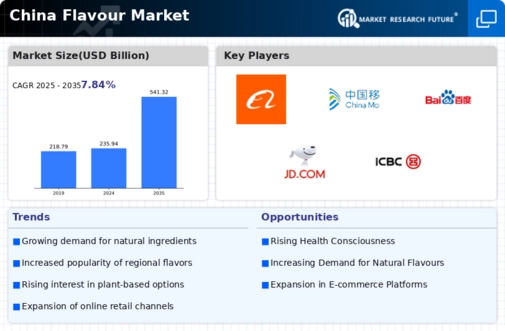Growing Health Consciousness
The increasing awareness of health and wellness among consumers in China is driving the flavour market. As individuals become more health-conscious, there is a notable shift towards natural and organic flavours. This trend is reflected in the rising demand for products that contain fewer artificial additives. According to recent data, the market for natural flavours is projected to grow at a CAGR of 8.5% over the next five years. This shift is influencing manufacturers to reformulate their products, thereby expanding the flavour market. Companies are investing in research and development to create healthier alternatives that appeal to this demographic, which is likely to enhance their market share.
Rising Demand for Convenience Foods
The fast-paced lifestyle of urban consumers in China is propelling the demand for convenience foods, which in turn is impacting the flavour market. As more individuals seek quick meal solutions, there is a growing need for ready-to-eat and easy-to-prepare products that do not compromise on taste. This trend is reflected in the increasing sales of packaged foods, which have seen a growth of 15% in the last year. Manufacturers are responding by enhancing the flavour profiles of these products to meet consumer expectations. This focus on convenience, coupled with appealing flavours, is likely to drive further growth in the flavour market.
Sustainability and Ethical Sourcing
The growing emphasis on sustainability and ethical sourcing is influencing consumer preferences in the flavour market. Chinese consumers are increasingly seeking products that are produced in an environmentally friendly manner and sourced responsibly. This shift is prompting manufacturers to adopt sustainable practices, such as using organic ingredients and reducing waste in production. Recent surveys indicate that approximately 70% of consumers are willing to pay a premium for sustainably sourced products. This trend is likely to drive innovation in flavour development, as companies strive to meet the expectations of environmentally conscious consumers, thereby enhancing their position in the flavour market.
Culinary Diversity and Fusion Trends
China's rich culinary heritage, combined with the influence of global cuisines, is fostering a dynamic environment for the flavour market. The growing trend of culinary fusion is encouraging consumers to experiment with diverse flavour profiles. This has led to an increase in demand for unique and exotic flavours, which are becoming more prevalent in both traditional and modern dishes. Market data indicates that the segment for fusion flavours is expected to grow by 12% annually. As chefs and food manufacturers innovate, they are likely to introduce new flavour combinations that cater to adventurous palates, thus expanding the flavour market.
Technological Advancements in Flavour Production
Innovations in flavour production technology are playing a crucial role in shaping the flavour market in China. Advances such as extraction techniques and flavour encapsulation are enabling manufacturers to create more intense and stable flavours. This technological progress is not only improving product quality but also reducing production costs. As a result, companies are able to offer a wider range of flavours at competitive prices. Market analysis suggests that the adoption of these technologies could lead to a 10% increase in market efficiency. Consequently, this trend is likely to attract new entrants into the flavour market, further stimulating competition.
















Leave a Comment